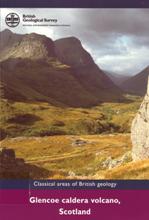Classical Areas of British Geology:
Glencoe Caldera Volcano, Scotland

Kokelaar, B P and Moore, I D
Published by: BGS
Publication date: 2006
ISBN: 0852725256 (book); 0751833002 (map)
List price: £22.00
127pp
www.bgs.ac.uk
It is not surprising that volcanoes – those wonderfully majestic conical edifices, and all that lava, ash and destruction so often tied to human catastrophe on an enormous scale - command so much attention. For these very reasons I was drawn to them when I first started out as a geologist, utterly captivated by eyewitness accounts of Pelée, Paracutin and Pinatubo. But while my interest in them has never waned, my expertise never became more than superficial, and it is as a hill walker, that I have passed through and around Glencoe on several occasions. Indeed, until relatively recently I had not even realised that Glencoe is an ancient volcanic complex! The BGS’s latest addition to its ‘Classical Areas of British Geology’ has therefore taught me mow much more there is to eruption, explosion and fallout than I had ever previously imagined.
The book claims to present the first complete reappraisal of the Glencoe volcano since the pioneering work of the Geological Survey 100 years ago, and it comes with a revised edition of the 1:25,000 solid geology map. At £22 it is a bargain! By way of introduction, it is fascinating to read how the first detailed analysis of the complex led to the theory of cauldron subsidence and then how this concept has evolved through time. That so much has been gleaned from the rocks of Glencoe is due to deep glacial incision that has exposed the roots of the volcanic system in 3D, creating ‘the world’s best exposed, tectonically controlled, multi-subsidence, piecemeal caldera volcano’. This mouthful highlights the only criticism I can level at the text –that at times the geoscience becomes a little dense. This is not because it is badly written, but because of the density of specialised terminology. For me – a somewhat volcanologically compromised reader – it became easier the more I read, as everything fell into place. However I suspect that some ‘amateurs interested in natural history’, at whom this book is aimed, may struggle.
Otherwise, the quality of the writing is first rate throughout. The organisation of the book also helps to ease less experienced readers into the ancient Glencoe world. I particularly like the way that the description of each stratigraphic unit (the biggest section of the book) is accompanied by a concise palaeoenvironmental interpretation, bulleted in the margin. Simply by reading the bullet points in sequence it is possible to visualise how the volcano evolved, step-by-step, without having to wade through the detail. There are also many schematic diagrams showing the volcano in eruption at different points in its life cycle. Most if not all of the main mappable units are also illustrated in striking, colour photographs, many supported by annotated diagrams, as an aid to interpretation and as a field guide for those who might visit the area. Indeed, with this in mind, the book closes with a detailed list of over 30 key exposures, complete with grid references and summary rock/structure descriptions.
Hill walking will take me back to Glencoe sooner or later; and when it does, out will come this book and its accompanying map – and the Three Sisters will never seem quite the same again.
Sean Mulshaw